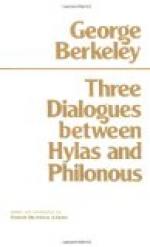HYL. And what will you conclude from all this? You cannot argue that there are really and naturally no colours on objects: because by artificial managements they may be altered, or made to vanish.
Phil. I think it may evidently be concluded from your own concessions, that all the colours we see with our naked eyes are only apparent as those on the clouds, since they vanish upon a more close and accurate inspection which is afforded us by a microscope. Then’ as to what you say by way of prevention: I ask you whether the real and natural state of an object is better discovered by a very sharp and piercing sight, or by one which is less sharp?
HYL. By the former without doubt.
Phil. Is it not plain from dioptrics that microscopes make the sight more penetrating, and represent objects as they would appear to the eye in case it were naturally endowed with a most exquisite sharpness?
HYL. It is.
Phil. Consequently the microscopical representation is to be thought that which best sets forth the real nature of the thing, or what it is in itself. The colours, therefore, by it perceived are more genuine and real than those perceived otherwise.
HYL. I confess there is something in what you say.
Phil. Besides, it is not only possible but manifest, that there actually are animals whose eyes are by nature framed to perceive those things which by reason of their minuteness escape our sight. What think you of those inconceivably small animals perceived by glasses? must we suppose they are all stark blind? Or, in case they see, can it be imagined their sight hath not the same use in preserving their bodies from injuries, which appears in that of all other animals? And if it hath, is it not evident they must see particles less than their own bodies; which will present them with a far different view in each object from that which strikes our senses? Even our own eyes do not always represent objects to us after the same manner. In the jaundice every one knows that all things seem yellow. Is it not therefore highly probable those animals in whose eyes we discern a very different texture from that of ours, and whose bodies abound with different humours, do not see the same colours in every object that we do? From all which, should it not seem to follow that all colours are equally apparent, and that none of those which we perceive are really inherent in any outward object?
HYL. It should.
Phil. The point will be past all doubt, if you consider that, in case colours were real properties or affections inherent in external bodies, they could admit of no alteration without some change wrought in the very bodies themselves: but, is it not evident from what hath been said that, upon the use of microscopes, upon a change happening in the burnouts of the eye, or a variation of distance, without any




